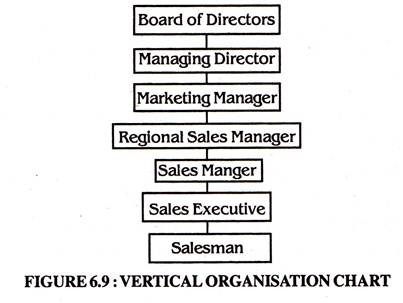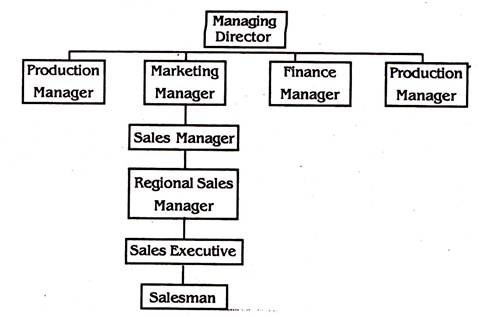Meaning of Organisation Chart:
Organisation Chart is the vital tool for providing information about organisational relationships. Organisation chart is a diagrammatical form, which shows the major functions and their respective relationships, the channels of formal authority and the relative authority of each manager who is incharge of each respective function.
George R. Terry defines an organisation chart as a “diagrammatical form, which shows important aspects of an organisation including the major functions and their respective relationship, the channels of supervision and the relative authority of each employee who is in charge of each respective functions.”
McFarland describes it, as “a type of record showing the formal organisation relationship with executive intend should prevail.”
ADVERTISEMENTS:
The organisation chart shows only formal relationships; the informal relationships are mostly transitory and flexible, so they are not depicted on the chart. It depicts formal relationships only at a given point of time.
Organisation charts can be divided into two:
(i) Master Charts,
ADVERTISEMENTS:
(ii) Supplementary Charts.
The master chart shows the entire formal organisation structure while the supplementary charts show details of relationships, authority, and the duties within the prescribed area of a department or major component of the organisation.
Types of Charts:
Organisation charts can be divided into the following three types based on preparation of organisation chart:
1. Vertical chart or Top-down chart.
ADVERTISEMENTS:
2. Horizontal Chart or left to right chart.
3. Circular Chart.
1. Vertical Chart:
It represents the level of organisation in the form of a pyramid lines of command proceed from top to bottom. In this chart highest position is shown at the top level and the lowest position is shown at the bottom level. This type of chart is given in Figure 6.9.
The chart shows that Managing Director controls the marketing manager who is one of the functional heads. Similarly marketing manager controls sales manager, performing a particular element of marketing function. This process goes on till we arrive at the level of salesmen, who really got the marketing functions performed at operation level.
2. Horizontal Chart:
It presents the level of organisation from left to right. The lines of command proceed horizontally. This shows the highest to the lowest level reading from left to right as shown in Figure 6.10.
It is not very common even though it serves the following advantages:
ADVERTISEMENTS:
i. It follows the normal reading habit of going from left to right.
ii. Visualises the various organisation levels clearly.
iii. Simplifies the understanding of how lines of formal authority and responsibility flow.
ADVERTISEMENTS:
iv. Indicates relative length of lines of formal authority.
3. Circular Chart:
The various positions or functions of an organisation can be shown in circular form. A concentric or circular chart shows top positions in the centre of concentric circles. Positions of relative equal importance are located at the same distance from the centre, that is, on the same concentric circle.
Lines joining the different blocks of functions or positions indicate the channels of formal authority. Its main weakness is that it is often confusing.
Meaning of Organisational Manual:
ADVERTISEMENTS:
Organisation chart cannot include all the detail, which is often desirable and necessary for understanding an organisation. But an organisation manual supplements and provides additional details to the information shown by the organisation chart.
Organisation manual is a small book containing information about the organisational objective, authority and responsibility of various positions and methods and procedures followed. The manual can be prepared either for the organisation as a whole or parts thereof.
The organisation manual consists the information such as organisational objectives and policies, job descriptions of major positions, organisational procedures, methods and rules.
Thus manual is classified into the following four types of manual:
1. Policy Manual
2. Operation Manual.
ADVERTISEMENTS:
3. Organisation Manual.
4. Rules and regulations manual.
Advantages of Organisation Chart and Manual:
1. Management Tool:
Organisation chart and manual provide information about the organisation structure, positions and authority. Therefore, an organisation chart and manual is considered as a vital tool of management.
2. Avoidance of Overlapping and Duplication:
Organisation chart and manual are prepared after careful analysis of jobs and positions requirements in the organisation and thereby, it ensures that all activities are covered properly by various positions and they will bring out very easily the organisational weakness. So they help to avoid overlapping of authority and responsibility and duplication of work.
ADVERTISEMENTS:
3. Solution of Organisational Conflicts:
Organisation Chart and manual clearly show the positions, authority relationships and procedures. They, therefore, provide ready reference for solving organisational conflicts. For example: Promotions.
4. Training Guides:
Organisation chart and manual evolve the expected work of employee in the organisation. Therefore, they can be used as a tool of on-the-job training.
5. Reference to Outsiders:
Since the organisational manual and chart clearly indicate the position, authority and responsibility, outsiders who are strangers to the organisation may know very easily with whom they have to interact for a particular work.
ADVERTISEMENTS:
Disadvantages of Chart and Manual:
The following limitations of chart and manual are given below:
1. Rigidity:
Organization Chart and manual provide rigidity in the organisational functioning. Many changes take place in the organization while chart and manual are in written form. Incorporation of changes, therefore, takes time. Further, written documents emotive people to bring changes. Newman observed long back “the sanctity of printed words tends towards inflexibility and more difficulty.”
ADVERTISEMENTS:
2. Partial View:
Organisation chart and manual represent only the limited picture of the total organization and its functioning. They show only official relationships and procedures. Managers should know the actual interactional patterns rather than merely formal ones to control the behaviour of the members in the organization.
Earnest Dale has commented, “Charts show the relationships which are supposed to exist but which may not be the fact.”
3. Inappropriate Description:
Organization chart merely depicts the reporting relationships that is who reports to whom. The exact quantum of authority and responsibility is not shown by the chart. Therefore, Organisation chart particularly provides inappropriate description of authority.
4. Psychological Problems:
ADVERTISEMENTS:
Organisation chart may create psychological problems among individuals in the organization. Because the chart puts people in superior or subordinate positions. So a feeling of superiority or inferiority may develop which may work against the team spirit. People in the lower level may not be willing that an organisation maintain the chart.

